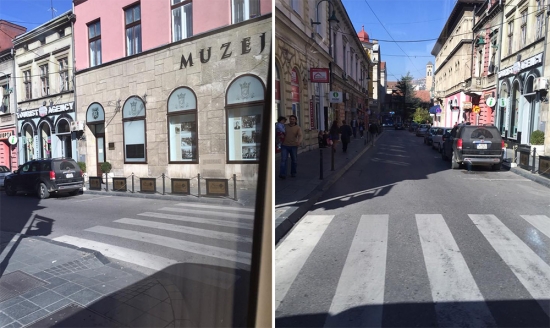Day 1: Visiting Sarajevo
Meeting the Prime Minister
Meeting with the current Prime Minister of Sarajevo
We were invited to attend government offices and meet with the Prime Minister of the canton of Sarajevo. While the weapons have now been put down for over 20 years, it struck me that in a way, an odd kind of cold war still continues and makes for an unstable and rocky political landscape in which it is difficult to get anything done. There are three different curricula in Sarajevo alone and no properly functioning educational ministry. The different ethnicities also take it in turns to lead the government which means that often what is started by one is left unfinished or vetoed by another.
We were given a tour of Sarajevo and were able to see first hand the fusion of culture that exists there including a Jewish synagogue, Muslim mosque and Christian church.
Following a traditional lunch of Borek (baked filled pastries made of a thin flaky dough, usually filled with meat, cheese or fruit) we visited some of Sarajevo’s museums documenting the conflict. Our visits to the Museum of War Childhood and Museum of Crimes Against Humanity and Genocide proved interesting yet uncomfortable as we saw one example after another of human suffering. The Museum of War Childhood gave the opportunity for people who had been children during the conflict to donate one object that provided memories or comfort during the dark days of the conflict. These were housed in cases along with their contextual information given by the people who had donated them. It was a powerful way of demonstrating the effect that war has on children.
Sarajevo and the First World War
Sarajevo is well known to most history teachers as the city in which the event that sparked the First World War took place – the assassination of Archduke Franz Ferdinand and his wife by Serb nationalists. Following the events of the First World War, Yugoslavia as a geographical entity was created with the Serbian royal dynasty as the Head of State.

The Sarajevo street corner at which Franz Ferdinand and his wife Sophie were fatally wounded sparking the First World War
Tito and Milosevic
The events of World War II led Yugoslavia to become a communist republic under the leadership of Tito. While Tito was a totalitarian dictator with a “life presidency” and his rule was seen as a dark time by some, Resad, our guide, explained that for some former Yugoslavians old enough to remember, Tito’s rule was a peaceful time, when ethnic and nationalist feelings were quelled – mainly because Tito was adept at appeasing all parties at the same time. For these people, Tito’s rule was more of a socialist than communist regime. Of course this is just one perspective of Tito’s rule, and I wondered how pervasive this was. Economic instability across Yugoslavia meant that by the time of Tito’s death in 1980, nationalist feeling was ripe to re-emerge.
Following Tito’s death, Slobodan Milosevic rose to power in Serbia in the late 1980s. His support of Serbs above other groups helped to stoke a new wave of Serb nationalism. In 1992, a referendum in Bosnia Herzegovina saw 66% vote for independence which was duly declared. Serbia’s response was to blockade Sarajevo. By May, the Yugoslav army which was mainly made up of Serbs was gathering around Sarajevo and the Siege of Sarajevo began. You can find out more about the events leading up to the break up of the former Yugoslavia by watching a BBC documentary from Norma Percy. This is freely available on YouTube

